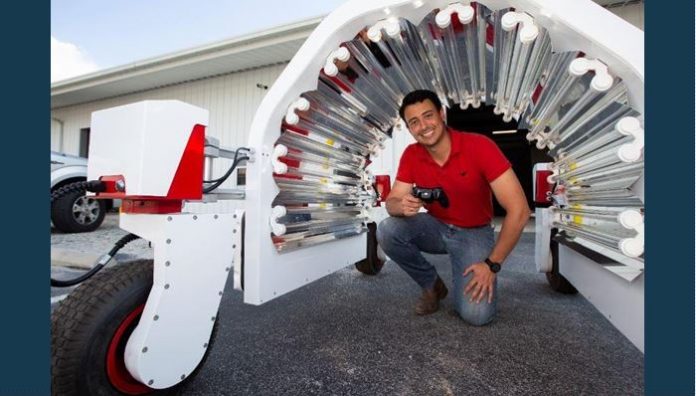
ORLANDO, Fla., April 18 (UPI) — Florida strawberry growers are investing heavily in robots to pick their crops and control disease, partly in response to declining farm laborer immigration.
Strawberry farmer Gary Wishnatzki has been developing robotic picking machines, named Berry, for seven years. And the University of Florida’s agriculture research teams in the Tampa area recently unveiled a spaceship-looking robot, named Thorvald, that roams fields at night bathing plants with ultraviolet light to kill powdery mildew.
The robots, which are being refined, move slowly through the fields. The UV robot runs quietly on battery power. The picking robot is more powerful, operating on a small diesel engine that energizes electric components. The current version of the machine spans four beds, with two rows each. Sixteen robotic picking wheels use soft silicone rubber claws that gently pluck ripe berries.
“The robotic unit definitely catches a lot of attention. It’s cool and has interest from technologists, and robotics save on labor cost,” said Natalia Peres, a professor of plant pathology at the university who has been developing Thorvald.
The strawberry industry is particularly interested in robotic farm machines because the berries are one of the most labor-intensive crops. Field workers, usually recent immigrants, still are used because machines in the past could damage the fruit. But hiring pickers has gotten more difficult for farmers like Wishnatzki.
“It does actually require some skill to pick strawberries, and the labor force that does it is aging,” Wishnatzki said. “Young people in Florida, in the U.S., don’t want to do this kind of work. There won’t be enough people to do the work in the coming years.”
Wishnatzki is a leader in the new technology, having founded Harvest CROO to develop Berry the robot. The company says it has raised over $9 million in investment so far. Investors listed on its website include big producers like California Giant, Driscoll’s and Naturipe Farms. Lucky Westwood, a vice president with Cal Giant, is a board member of the startup.
Currently, Berry is only being used at Wishnatzki’s Wish Farms site in Duette, Fla. Wishnatzki plans to have two more machines in California next year.
The National Science Foundation awarded a $1 million grant to Harvest CROO in 2016 through the Small Business Innovation Research program.
Small Business Innovation Research officials have estimated the industry spends $1 billion per year on picking, so implementing robotics could cut the cost to growers appreciably.
As for disease-killing UV robots, they are being studied at a U.S. Department of Agriculture center in West Virginia. But the one in Florida, Thorvald, actually works on the land.
“Most, if not all, of previous work has been done small-scale in greenhouses,” Peres said. “What differentiates what our group is doing is that we are doing it in open production fields.”
The University of Florida is collaborating with researchers at Cornell University in Ithaca, N.Y., Rensselaer Polytechnic Institute in Troy, N.Y., and the Norwegian University of Life Science near Oslo.
Thorvald is able to kill mildew only at night because it catches the fungus while it’s napping in the dark. Research showed that mildew repairs damage from UV rays during the day, but that repair ability doesn’t work at night.
“We are really just scratching the surface of how we can use light to suppress plant pathogens and pests,” said David Gadoury, senior research associate at Cornell. “Until now, the focus has been on optimizing light for plant growth, but we can trick the enemies of plants with lighting to tip the balance towards plant health.”
Research around the world has predicted a coming food crisis that can only be solved by greater automation and artificial intelligence as global population pushes past 8 billion people in 2025, according to United Nations estimates.
For example, a 2016 article in International Journal of Engineering Science Invention Research & Development said traditional methods of farming and declines in the availability of farm labor are failing to keep up with demand.
Without robotics, the price of strawberries could rise dramatically in the coming years, Wishnatzki said.
“It’s not necessarily about immigration, it’s about demographics,” he said. “The farm labor pool is smaller, but there are more mouths to feed.”



